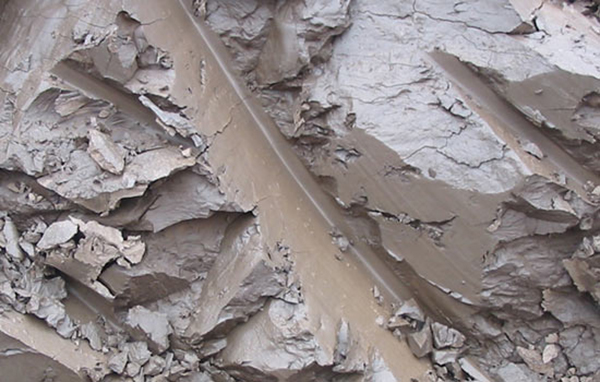Clay
Clay is a fine-grained natural rock or soil material that combines one or more clay minerals with traces of metal oxides and organic matter. Clays are plastic due to their water content and become hard, brittle and non–plastic upon drying or firing. Geologic clay deposits are mostly composed of phyllosilicate minerals containing variable amounts of water trapped in the mineral structure. Depending on the soil's content in which it is found, clay can appear in various colours from white to dull grey or brown to deep orange-red. Clays are distinguished from other fine-grained soils by differences in size and mineralogy. Silts, which are fine-grained soils that do not include clay minerals, tend to have larger particle sizes than clays.
Formation
Clay minerals typically form over long periods of time as a result of the gradual chemical weathering of rocks, usually silicate-bearing, by low concentrations of carbonic acid and other diluted solvents. These solvents, usually acidic, migrate through the weathering rock after leaching through upper weathered layers. In addition to the weathering process, some clay minerals are formed through hydrothermal activity. There are two types of clay deposits: primary and secondary. Primary clays form as residual deposits in soil and remain at the site of formation. Secondary clays are clays that have been transported from their original location by water erosion and deposited in a new sedimentary deposit. Clay deposits are typically associated with very low energy depositional environments such as large lakes and marine basins.

Uses
From prehistoric times, clay has been indispensable in architecture, in industry, and in agriculture. As a building material, it is used in the form of brick, either sun-dried (adobe) or fired. Clays are also of great industrial importance, e.g., in the manufacture of tile for wall and floor coverings, of porcelain, china, and earthenware, and of pipe for drainage and sewage. Highly absorbent, bentonite is much used in foundry work for facing the moulds and preparing the moulding sands for casting metals. The less absorbent bentonites are used chiefly in the oil industry, e.g., as filtering and deodorizing agents in the refining of petroleum and, mixed with other materials, as drilling muds to protect the cutting bit while drilling. Other uses are in the making of fillers, sizing’s, and dressings in construction, in clarifying water and wine, in purifying sewage, and in the paper, ceramics, plastics, and rubber industries.
Questions
1. Tell me if you think this pit was a primary or secondary deposit and why?
2. Briefly describe the difference between erosion and weathering?
3. Describe any evidence of erosion you can see.
4. Looking around the pit several colours are visible please list the 3 most common.
Please feel free to log at your leisure, but logs without corresponding message will be deleted.